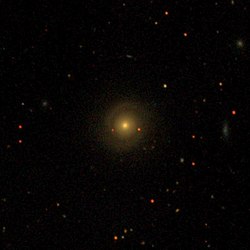NGC 7558
| Galaxie NGC 7558 | |
|---|---|
 | |
| SDSS-Aufnahme | |
| AladinLite | |
| Sternbild | Pegasus |
| Position Äquinoktium: J2000.0, Epoche: J2000.0 | |
| Rektaszension | 23h 15m 38,2s [1] |
| Deklination | +18° 55′ 11″ [1] |
| Erscheinungsbild | |
| Morphologischer Typ | E? / Sa[1] |
| Helligkeit (visuell) | 14,9 mag[2] |
| Helligkeit (B-Band) | 15,9 mag[2] |
| Winkelausdehnung | 0,4' × 0,4'[2] |
| Flächenhelligkeit | 12,9 mag/arcmin²[2] |
| Physikalische Daten | |
| Zugehörigkeit | HCG 93[1] |
| Rotverschiebung | 0,029624 ± 0,000130[1] |
| Radialgeschwindigkeit | (8881 ± 39) km/s[1] |
| Hubbledistanz H0 = 73 km/(s • Mpc) | (405 ± 28) · 106 Lj (124,1 ± 8,7) Mpc [1] |
| Geschichte | |
| Entdeckung | Albert Marth |
| Entdeckungsdatum | 3. November 1864 |
| Katalogbezeichnungen | |
| NGC 7558 • PGC 70844 • MCG +03-59-016 • 2MASX J23153820+1855111 • HCG 93E • GALEXASC J231538.27+185512.3 • NSA 150918 | |
NGC 7558 ist eine Galaxie vom Hubble-Typ S? im Sternbild Pegasus nördlich der Ekliptik. Sie ist schätzungsweise 405 Millionen Lichtjahre von der Milchstraße entfernt und hat einen Durchmesser von etwa 45.000 Lichtjahren.
Gemeinsam mit NGC 7547, NGC 7549 und NGC 7550 bildet sie die Galaxiengruppe HCG 93.
Das Objekt wurde am 3. November 1864 vom deutschen Astronomen Albert Marth entdeckt.[3]
Literatur
- König, Michael & Binnewies, Stefan (2019): Bildatlas der Galaxien: Die Astrophysik hinter den Astrofotografien, Stuttgart: Kosmos, S. 206
Weblinks
Einzelnachweise
Auf dieser Seite verwendete Medien
Autor/Urheber: Sloan Digital Sky Survey, Lizenz: CC BY 4.0

Angle of view: 4' × 4' (0.3" per pixel), north is up.
Details on the image processing pipeline: https://www.sdss.org/dr14/imaging/jpg-images-on-skyserver/